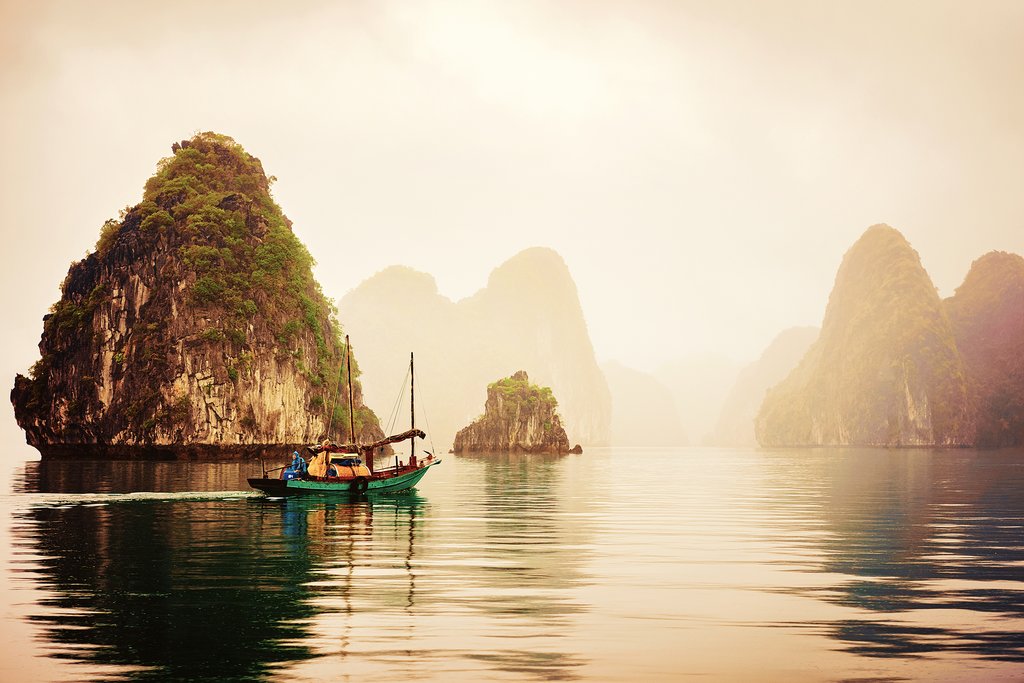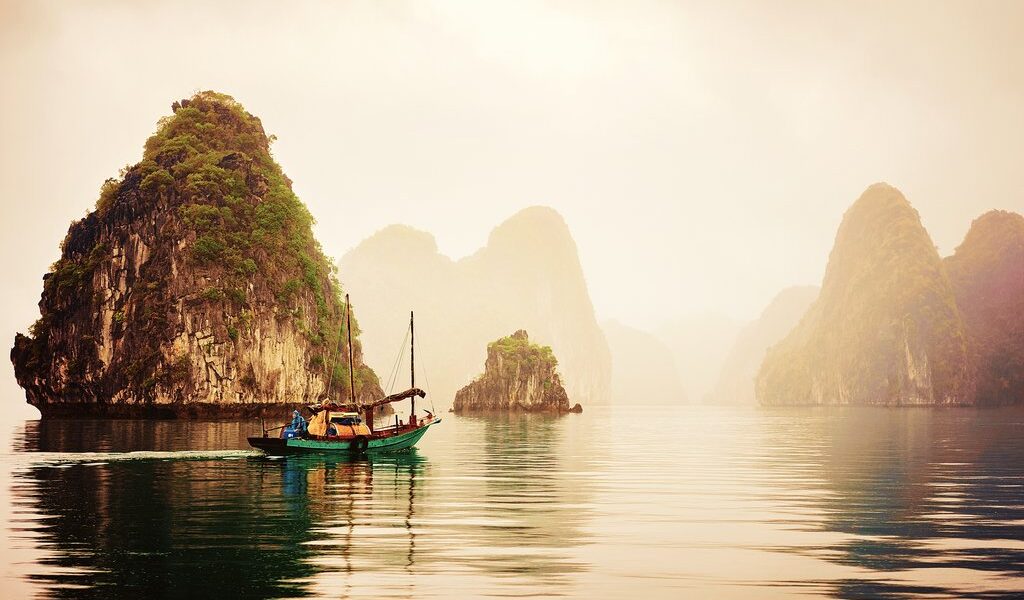
February is a great month to travel in Vietnam, with mostly gorgeous sunny weather throughout the country. Visitor numbers are higher than January or March: in fact, this is the second busiest month of the year. And Vietnam’s premier celebration, Tet (Vietnamese New Year), culminates a month full of festivals that add cacophonous color and fun.
**Weather**
February in Vietnam presents a delightful tapestry of weather conditions, varying from north to south, ensuring a memorable experience for every type of traveler. The central and southern regions, in particular, are bathed in sunshine and boast comfortably warm temperatures, making it an ideal time to explore these vibrant locales.
Central and South Vietnam are truly blessed with what can only be described as absolutely perfect beach weather. “Summer” is in full swing, especially at renowned resorts such as Danang and Hoi An. Imagine yourself basking in the glorious sunshine, with average temperatures hovering around a near-perfect 77°F (25°C). While occasional refreshing showers may grace the landscape, they are unlikely to dampen your spirits or hinder your enjoyment of the coastal beauty.
Moving inland, the areas around Dalat and the Central Highlands offer a slightly cooler climate, providing a welcome respite from the heat and creating the perfect conditions for hiking, trekking, and a wide array of other adventure activities. If you plan to explore these regions, it is advisable to pack a light jacket, particularly for the evenings when the temperature tends to dip slightly.
Venturing further south, you’ll find temperatures that are a bit warmer, averaging between 79-86°F (26-30°C) around popular resorts such as Phan Thiet and Ho Tram. The heat intensifies as you approach Ho Chi Minh City and the expansive Mekong Delta. In these regions, you can expect sprinklings of light rain, typically in the form of refreshing afternoon showers or short-lived downpours. These brief spells of rain help to keep the temperatures temperate and prevent the humidity from becoming overwhelming. While the really hot and humid weather characteristic of the wet season is still a few months away, it’s still wise to pack a light, rainproof jacket along with your shorts and other light clothing to be prepared for any unexpected showers.
In stark contrast to the warmth of the south, the northern regions of Vietnam experience significantly cooler temperatures in February. The weather is frequently overcast, and conditions can often be misty or foggy, particularly at night. If you’re planning a trip to the north, be sure to pack a warm jacket to keep you comfortable. This is especially important if you intend to visit the highlands of Sapa, where the temperature remains consistently cold, averaging around 63°F/17°C. The cooler weather in the north offers a unique perspective on Vietnam’s diverse climate and allows for different types of travel experiences.
**Crowds & Costs**
February falls squarely within the high season for tourism in Vietnam. The country experiences a significant influx of visitors, making it busier than both January and March. The primary draw is the delightful weather in the central and southern regions, which attracts tourists eager to enjoy the beach resorts before the intense heat and humidity of the summer months set in.
While Northern Vietnam remains relatively cool, it still attracts a fair number of visitors, primarily due to it being the dry season. This makes it an ideal time for trekking and exploring the region’s stunning natural landscapes.
However, travelers should be aware that February also coincides with Tet, the Vietnamese New Year. This is a major holiday in Vietnam, and it involves widespread travel as locals return to their ancestral homes to celebrate with family. During this period, many shops, restaurants, and museums close their doors for the duration of the festivities. This can impact the availability of certain services and activities, so it’s important to plan accordingly.
Surprisingly, despite being high season, flight prices to and from Vietnam tend to be lower in February compared to the summer or mid-winter months. This can make it a more affordable time to travel to the country, particularly for those on a budget. The price of accommodations, on the other hand, tends to vary only marginally throughout the year. Prices in February are only slightly higher than the annual average, so you can expect to pay a bit more for lodging compared to other times of the year.
However, there are some regional variations in accommodation costs. For instance, lodging costs in Ho Chi Minh City can be significantly higher in February due to increased demand. Conversely, February is often the cheapest month of the year for accommodations in Hanoi, which makes it an attractive destination for budget-conscious travelers.
**Where to Go**
February is arguably the perfect month to indulge in a beach vacation in Vietnam. The coastal resorts are blessed with abundant sunshine, while the temperatures remain comfortably warm without being excessively hot. Pack your sunscreen, beach towel, and swimsuit, and prepare to unwind on some of the most beautiful beaches in the country.
Consider heading to Phu Quoc or Con Dao islands, two tranquil tropical paradises located off the southern tip of Vietnam. These islands offer pristine beaches, crystal-clear waters, and a laid-back atmosphere that is perfect for relaxation and rejuvenation. Alternatively, you can combine an exploration of the bustling metropolis of Ho Chi Minh City with a relaxing stay at one of the nearby coastal resorts, such as Ho Tram or Phan Thiet.
For adventure seekers, the North of Vietnam beckons with its stunning landscapes and mild temperatures. Spring is in the air north of the Bach Ma mountains, and the gorgeous upland landscapes are adorned with colorful flowers. The temperatures are delightfully mild, making it ideal for mountain trekking near Sapa and for wandering around the ancient town of Hoi An.
And then there’s Hanoi, one of the most ancient capitals in the world. This vibrant city offers a multi-cultural experience, boasting ancient pagodas, French colonial architecture, unique museums, great shopping opportunities, and the chance to witness the Tet celebration at its most vibrant.
One of the best places to fully immerse yourself in the Tet (Vietnamese New Year) festivities is Hoi An, particularly for its captivating Lantern Festival. During this time, much of the city is adorned with colorful lanterns, with scores of traditional workshops vying to create the most beautiful and eye-catching displays. Immerse yourself in the spontaneous seven-day celebration, which is primarily centered in the old town.
Consider hiring a sampan for a leisurely boat ride along the river, surrounded by the mesmerizing sight of floating lanterns. And don’t forget to purchase your own lantern and set it afloat for good luck, a tradition that is deeply ingrained in Vietnamese culture.
**What to Do**
February presents an ideal opportunity to explore the waterways of the Mekong Delta. The water levels are high enough to make it the prime time for visiting the vibrant floating markets, where you can witness the bustling trade and experience the unique culture of the river communities.
This is also an excellent month for embarking on sailing trips upriver. You can witness the languid river life at its busiest, and admire the ancient Khmer pagodas and stilted villages that dot the landscape, set amidst a backdrop of lush rice paddies. For the more adventurous travelers, consider hitching a ride on a cargo boat and sleeping in a hammock beneath the stars, an unforgettable experience that will bring you closer to the heart of the Mekong Delta. For those seeking greater comfort, you can opt for one of the many commercial cruise packages that depart from Vinh Long or other river ports.
Hue, situated on the banks of the Perfume River midway between Hanoi and Ho Chi Minh City, is a city steeped in history and dotted with important and impressive historical sites. Rent a bicycle or hire a cyclo taxi and explore the city like a local, immersing yourself in its rich cultural heritage.
Be sure to visit iconic sites such as Vong Canh Hill, which offers splendid panoramic views of the city and the Perfume River. Descend from the hill to explore the exquisite Tu Hieu pagoda, nestled amidst a serene pine forest. Marvel at the grandeur of the tomb of Emperor Minh Mang, and delve into the history of the walled Imperial Citadel, a UNESCO World Heritage Site that stands as a testament to Vietnam’s imperial past.
**February Events**
* **Tet, Vietnamese New Year:** Without a doubt, the most significant festival of the year. This joyous occasion typically falls between late January and mid-February. The celebrations extend for a full week, radiating an infectious festive spirit throughout the entire nation. Numerous cities across Vietnam host their own unique festivities, enriching the tapestry of Tet celebrations. Experiencing Tet in Vietnam is a cultural immersion unlike any other.
* **Quang Trung Festival:** A vibrant and energetic celebration marked by captivating drum performances, mesmerizing lion dances, and a fascinating display of human chess. This festival takes place at Hanoi’s Dong Da Mound on the fifth day of the first lunar month. It serves as a commemoration of the uprising led by Emperor Quang Trung (Nguyen Hue) against the Chinese army in 1788, a pivotal moment in Vietnamese history.
* **Perfume Pagoda Festival:** Held immediately following the Tet festivities, this is one of the most significant pilgrimage festivals in Vietnam. It’s held at the Huong Pagoda, the country’s most revered Buddhist pilgrimage site, about 40 miles (70 km) southwest of Hanoi. Devout Buddhists and curious travelers alike converge on this sacred site to pay homage, offer prayers, and partake in the spiritual ambiance. The journey to the pagoda itself is part of the experience, often involving boat rides and hikes through stunning natural landscapes.
B-2734

